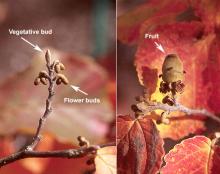Hamamelis × intermedia
Common name:
Witchhazel
Pronunciation:
ham-a-MAY-lis in-ter-ME-di-a
Family:
Hamamelidaceae
Genus:
Type:
Broadleaf
Native to (or naturalized in) Oregon:
No
- Deciduous shrub/tree, 15-20 ft (4.5-5 m), upright- or wide-spreading, open, not densely branched. Leaves alternate, simple, roundish or broadly oval, 5-10 cm long, often with wavy margins, turn yellow to a rich red in fall, depending on the cultivar, of which there are many. Blooms in winter or early spring prior to leaf emergence. Fragrant flowers, yellow to red, 4 narrow, strap-shaped petals, 15-20 mm long. Fruit is a two-parted capsule about 1 cm long, each part contains a single glossy black seed. Brown when mature; they split open and eject the seeds with force.
- Sun to part shade. Best in moist, but not wet acid soil. Generally problem free with regard to insects and diseases. Sometimes in the fall leaves die and turn brown but do not drop, and if not removed, this greatly detracts from the flower display in late winter/early spring.
- Hardy to USDA Zone 5 Hamamelis × intermedia, a hybrid of H. japonica and H. mollis.
-
Dirr (1998, p. 421) gives brief descriptions of some 25 cultivars. Some of the common cultivars include:
- 'Arnond Promise' - clear yellow flowers, fall leaf color yellow, orange, reddish.
- 'Diane' - copper-red flowers, fall foliage yellow, orange, to red.
- 'Jelena' ('Copper Beauty', 'Orange Beauty') - copper flowers, fall color orange red.
- 'Primavera' - yellow flowers, purple-red at base, yellow-orange fall color.
- 'Ruby Glow' - copper-red flowers changing to reddish-brown, reddish fall color.








